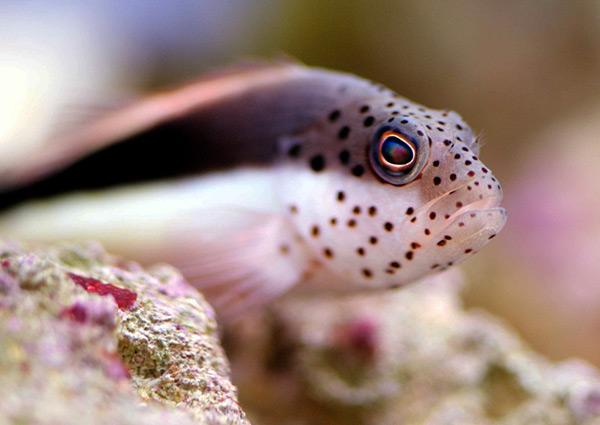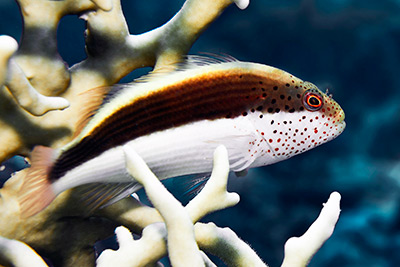When it comes to keeping hawkfishes in aquaria, one of the more common admonitions is to avoid housing these predators with fish or crustaceans small enough to swallow. For most of the hawkfish species that grace our tanks, which generally have a maximum size somewhere between 3 and 5 inches, only very small tankmates are truly at risk.
A noteworthy exception is the freckled hawkfish (Paracirrhites forsteri), which can reach a rather prodigious size and has a mouth to match. You really have to take that warning seriously with this species! That said, P. forsteri is a hardy, easy-to-care-for hawk that makes a worthy aquarium candidate provided tankmates and housing are chosen judiciously.
Physical traits
P. forsteri has the deep, stout body and high-set eyes, typical of the hawkfishes. Its maximum size is approximately 8½ inches. Coloration changes as the fish matures and varies considerably by individual and collection locale. Most specimens I’ve come across in local fish stores have exhibited a dark band (red, brown, or black) on the dorsal half of the body and yellow or white coloration on the ventral half. What’s consistent among specimens is the source of this species’ common name—red dots freckling the face.

Feeding
As alluded above, P. forsteri is a predator on small fish and crustaceans. In captivity, it takes to feeding readily and will accept a wide variety of meaty foods, such as mysids; chopped fish, crustacean, or mollusk meat; and frozen formulas for carnivores.
Housing
A bottom-dwelling species that is usually found perched on rockwork or branching stony corals with the front of its body propped on its pectoral fins, P. forsteri doesn’t demand a great deal of open swimming space. For a single specimen, a tank in the vicinity of 75 gallons would suffice for minimum housing. However, if you plan to keep one with tankmates—which must be decent-sized to avoid becoming a meal—a larger tank might be more appropriate.
Compatibility
P. forsteri is an aggressive species that will harass tankmates that are similar in appearance and/or attempt to occupy the same niche in the aquarium, including conspecifics (with the possible exception of mated pairs in large tanks). Generally speaking, it should arrive late or last in the order of introduction. Suitable tankmates include similarly sized or larger species that swim in open water, such as larger tangs, rabbitfishes, angelfishes, or community-friendly triggers.

Though this species is technically reef-safe in the sense that it won’t eat or nibble on sessile invertebrates, it wouldn’t be my first choice for such a system. One concern is that hawkfishes have a tendency to perch on corals and will sometimes settle on the same specimen over and over again, which can become a major irritant and prevent the coral from expanding fully. There’s also the issue of this species being a rather voracious feeder and copious waste produce, which can be detrimental to water quality.



